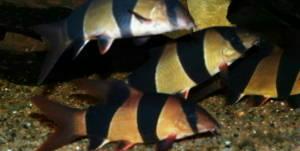Loach - Clown
Scientific Name: Botia macracanthus
Fri, 11th April, 2025 - 11:07 pm GMT
Sponsor Ads:

Alternative Name
Scientific Name: Botia macracanthusBasic Info
The Clown Loach gets its name not only from its playful personality, but also from the orange and white stripes that line its body, much like a Tiger Barb or Clown fish. They have long narrow snake like bodies. They move around by waving their body, much like an eel. Clown Loaches can reach a size of 10 to 12 inches at maturity.
Health
Clown Loaches are a hardy species. They should be in water with a temperature between 77 and 84 degrees Fahrenheit. Their water should have a pH in a range of six to seven and a half. Clown Loaches are a little more prone to Ich than most fish. Special care should be taken when the Loaches have Ich, or Whitespot. There is a lot of debate about which chemicals can be used safely with Clown Loaches. Many Ich treatments contain copper, and some sources state that is okay for Clown Loaches, while others say it should be avoided. In either case, no matter what chemical is used for treatment, Clown Loaches (and all other scale-less fish) should ONLY get HALF to three-quarter strength treatment. This is because their skin is so thin, and more than that will usually poison the fish. Make sure to read the label on the Ich treatment; some will specifically say not to use on scale-less fish. When treating, it is a good idea to turn out the light and cover the tank; it reduces stress on the Loaches and Ich has been found to thrive in light and colder waters. You can raise the temperature with the Clown Loaches to between 80 and 82 degrees Fahrenheit during treatment; even if the Ich treatment says it is not necessary, once again, Ich does not thrive in warmer waters. Take care not to keep invertebrates (snails, crabs, etc) in the tank during an Ich treatment or they will inevitably die. Also, check with your vet or local fish store about keeping amphibians in the tank during an Ich treatment. As far as the causes of Ich in Loaches, the most prominent cause is stress. When at your local fish store, make sure that more than three Clowns are kept in a tank together before considering purchase. They are very social fish and get lonely easily. Also, the larger the fish, the older it is, and the greater chance of survival the fish will have. Moving (from the fish store to your tank, in between tanks, etc) is the most stressful thing your Clown will ever have to go through. They see a net - they hide. It helps to carefully remove decorations if you are moving more than one fish, or they will squeeze into impossibly tiny nooks and crannies. Also, Clown Loaches have a sub-ocular spine the protrudes from beneath the eye, therefore when using a net to catch a Clown Loach, you should be careful not to allow this spine to caught on the net. A Clown Loach will most likely display signs of illness, especially Ich, during and after a move. Special care should be taken at these times. Breeding Clown Loaches will not breed until they reach sexual maturity, which does not occur until later in life and only when the fish is large (7-11 inches). This fish is VERY difficult to breed in captivity. It has been reported that there has only been one documented case of a successful spawning in captivity, in the United Kingdom in the late 1990s, about five years ago. One of the reasons they are so difficult is because Clown Loaches grow at a rate of about 1 inch per year, it will take up to 8 years for them to be even viable breeding adults. If you do attempt to breed a lower pH level should be used, around six, and water changes should be implemented to help stimulate breeding. Male and female Clown Loaches are indistinguishable. This fish is also interesting because it can change sex as needed to promote breeding conHabitat
Fresh water fishBehavior
The Clown Loach is a fun, playful and interesting fish. With its unique snake shape, great personality and feeding habits, the Clown Loach makes an aquarium complete. They are recommended for most community aquariums. Clown Loaches are a peaceful and friendly fish. Many have reported being able to hand feed their Clown Loaches. They are very active fish, swimming constantly and they especially seem to enjoy bubble walls. Any tank with Clown Loaches should have at least three, as one will feel insecure and two will fight. Often Clown Loaches will be found lying on their sides. This does not mean their dead, their just resting. Although some hobbyists recommend a rocky substrate because the Clown Loach enjoys digging, a rocky substrate tends to wear down the delicate barbels of Botia Macracanthus and so a sandy substrate is preferred. They should have plenty of hiding places, but they do tend to get stuck in small openings, so be careful. Moderate plant and rock decorations are recommended. This can be a curse or a blessing. If you have an unwanted snail outbreak from new plants, etc. a few Clown Loaches will help to crush the infestation. On the downside, it is not advised to keep decorative snails, such as the Apple Snail in a tank with Clown Loaches.Origin
IndonesiaHistory
The Clown Loach, or Botia macroacanthus is originally from Indonesia and Borneo.Common Foods
The Clown Loach loves to eat snails!Sponsor Ads:
Thoughts on Programming, Number 59: I write all my critical routines in assembler, and my comedy routines in FORTRAN. -Anonymous
Loach - Clown
Coded by: BGID® | ALL RIGHTS RESERVED Copyright © 2000-2025
Disclaimer | Privacy | Report Errors / Contact | Credits
















